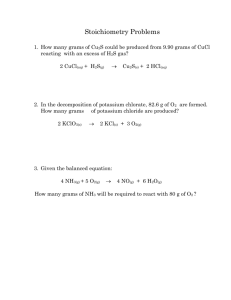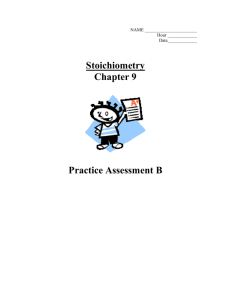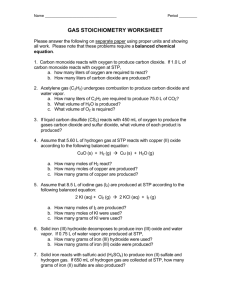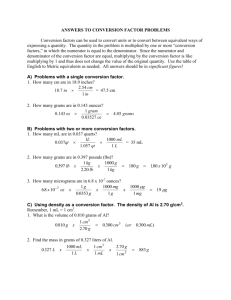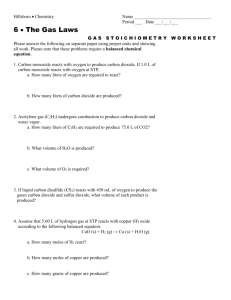IB - Quantitative Chemistry Review answers
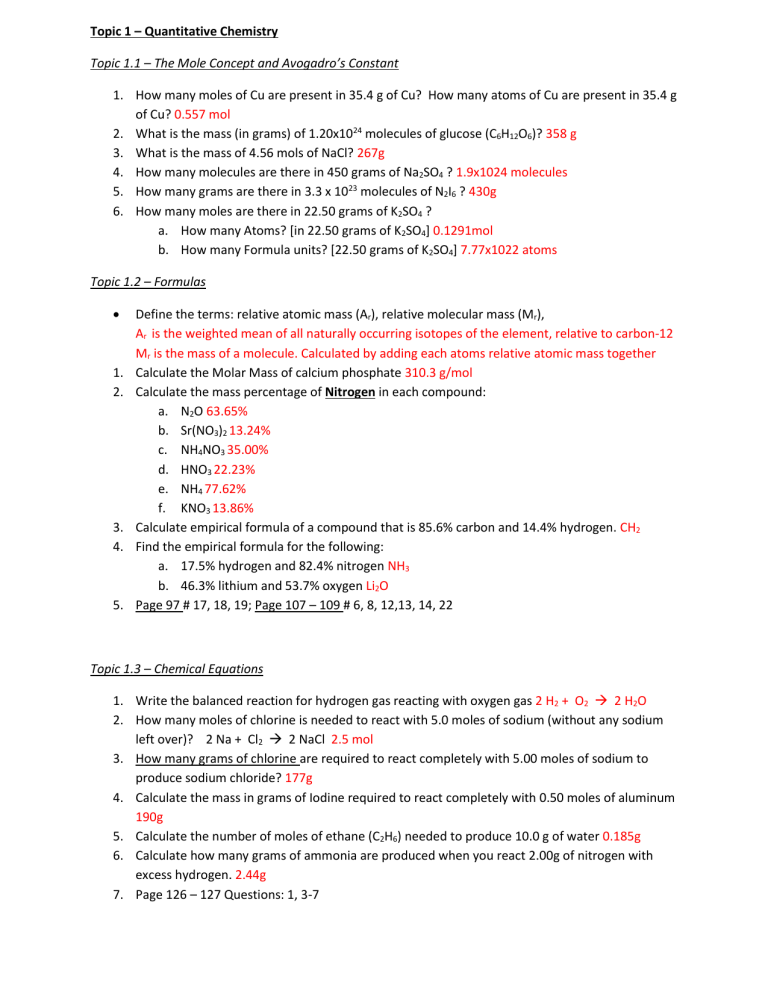
Topic 1 – Quantitative Chemistry
Topic 1.1 – The Mole Concept and Avogadro’s Constant
Topic 1.2 – Formulas
Define the terms: relative atomic mass (A r
), relative molecular mass (M r
),
A r
is the weighted mean of all naturally occurring isotopes of the element, relative to carbon-12
M r
is the mass of a molecule. Calculated by adding each atoms relative atomic mass together
1.
Calculate the Molar Mass of calcium phosphate 310.3 g/mol
2.
Calculate the mass percentage of Nitrogen in each compound: a.
N
2
O 63.65% b.
Sr(NO
3
)
2
13.24% c.
NH
4
NO
3
35.00% d.
HNO
3
22.23% e.
NH
4
77.62% f.
KNO
3
13.86%
3.
Calculate empirical formula of a compound that is 85.6% carbon and 14.4% hydrogen. CH
2
4.
Find the empirical formula for the following: a.
17.5% hydrogen and 82.4% nitrogen NH
3 b.
46.3% lithium and 53.7% oxygen Li
2
O
5.
Page 97 # 17, 18, 19; Page 107 – 109 # 6, 8, 12,13, 14, 22
1.
How many moles of Cu are present in 35.4 g of Cu? How many atoms of Cu are present in 35.4 g of Cu? 0.557 mol
2.
What is the mass (in grams) of 1.20x10
24 molecules of glucose (C
6
H
12
O
6
)? 358 g
3.
What is the mass of 4.56 mols of NaCl? 267g
4.
How many molecules are there in 450 grams of Na
2
SO
4
? 1.9x1024 molecules
5.
How many grams are there in 3.3 x 10 23 molecules of N
2
I
6
? 430g
6.
How many moles are there in 22.50 grams of K
2
SO
4
? a.
How many Atoms? [in 22.50 grams of K
2
SO
4
] 0.1291mol
b.
How many Formula units? [22.50 grams of K
2
SO
4
] 7.77x1022 atoms
Topic 1.3 – Chemical Equations
1.
Write the balanced reaction for hydrogen gas reacting with oxygen gas 2 H
2
+ O
2
2 H
2
O
2.
How many moles of chlorine is needed to react with 5.0 moles of sodium (without any sodium left over)? 2 Na + Cl
2
2 NaCl 2.5 mol
3.
How many grams of chlorine are required to react completely with 5.00 moles of sodium to produce sodium chloride? 177g
4.
Calculate the mass in grams of Iodine required to react completely with 0.50 moles of aluminum
190g
5.
Calculate the number of moles of ethane (C
2
H
6
) needed to produce 10.0 g of water 0.185g
6.
Calculate how many grams of ammonia are produced when you react 2.00g of nitrogen with excess hydrogen. 2.44g
7.
Page 126 – 127 Questions: 1, 3-7
Topic 1.4 - Mass and Gaseous volume relationships in chemical reactions
1.
10.0g of aluminum reacts with 35.0 grams of chlorine gas to produce aluminum chloride.
Which reactant is limiting, which is in excess, and how much product is produced?
43.9g
2.
15.0 g of potassium reacts with 15.0 g of iodine. Calculate which reactant is limiting and how much product is made 19.6g
3.
Page 131 # 23, 24, 25; Page 134 # 27 and 29
4.
20.0 g of HBrO
3
is reacted with excess HBr. What is the theoretical yield of Br
2
? 74.4g;
63.6%
What is the percent yield, if 47.3g is produced? HBrO
3
+ 5HBr 3H
2
O + 3 Br
2
5.
When 35.0 g of Ba(NO
3
)
2
is reacted with excess Na
2
SO
4
, 29.8g of BaSO
4
is recovered.
Ba(NO
3
)
2
+ Na
2
SO
4
BaSO
4
+ 2NaNO
3
Calculate the theoretical yield and the percent yield of BaSO
4
31.3g; 95.2%
6.
Pg.139 # 31, 33; Pg. 141 # 35
7.
A chemical reaction produces 0.0680 mol of oxygen gas. What volume in liters is occupied by this gas sample at STP? 1.52L
8.
A chemical reaction produced 98.0 mL of sulfur dioxide gas at STP. What was the mass of gas made? 0.280g
9.
A chemical reaction produced 3.1 g of CO
2
gas. What volume will it have in mL at STP?
1600mL
10.
How many moles of gas are in a container with a volume of 2.46 dm 3 at STP? 0.110mol
11.
Assume all volumes are measured at the same temperature and pressure.
What volume of nitrogen forms when 100 cm 3 of ammonia decomposes completely into its elements. What volume of oxygen is needed to react with 40 cm 3 of butane,C
4
H
10
,and what volume of carbon dioxide is produced?
50cm 3 ; 260 cm 3 ; 160 cm 3
12.
Calculate the volume occupied by 4.40g of carbon dioxide at standard temperature and pressure.
2.24 dm 3
13.
Calcium reacts with water to produce hydrogen. Calculated the volume of the gas, measured at STP produced when 0.200g of calcium reacts completely with water?
0.112 dm 3


